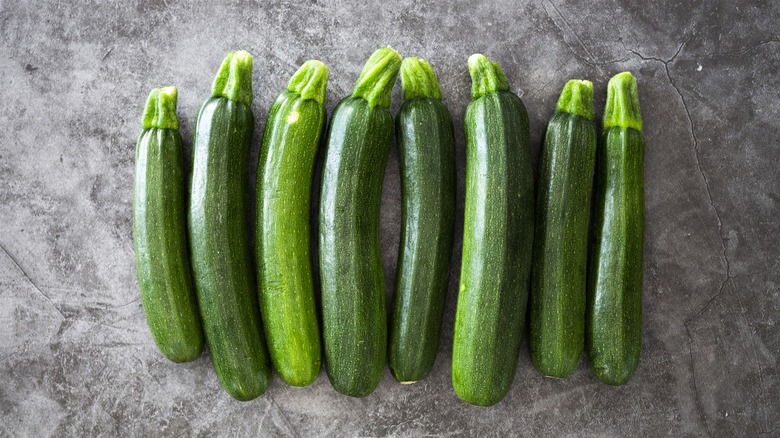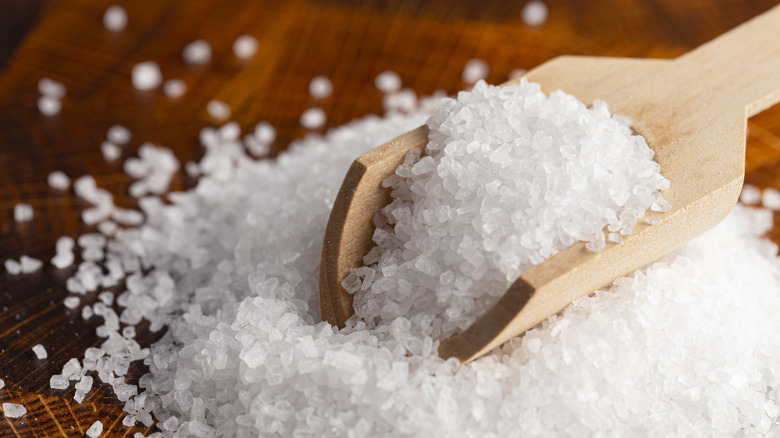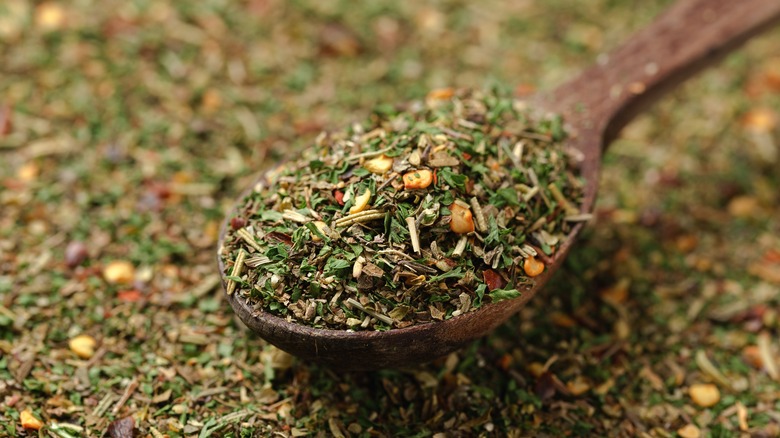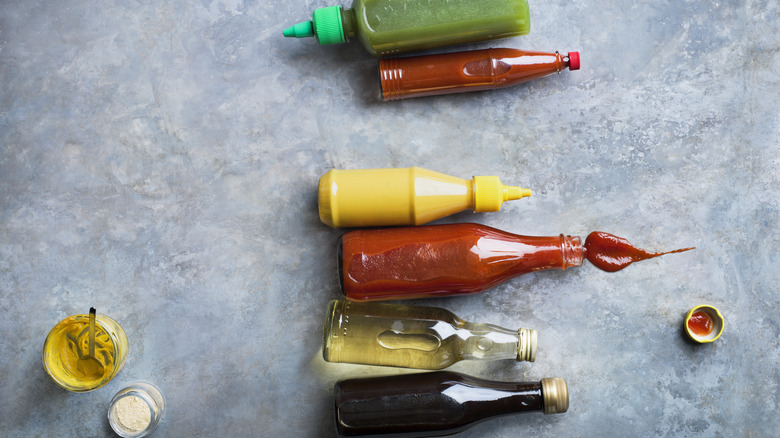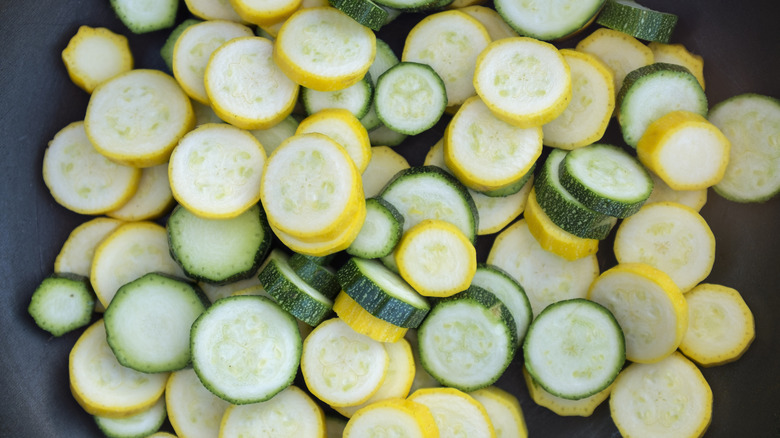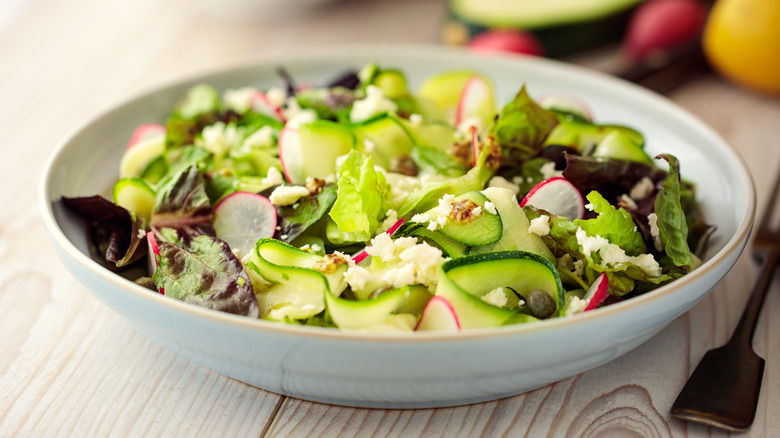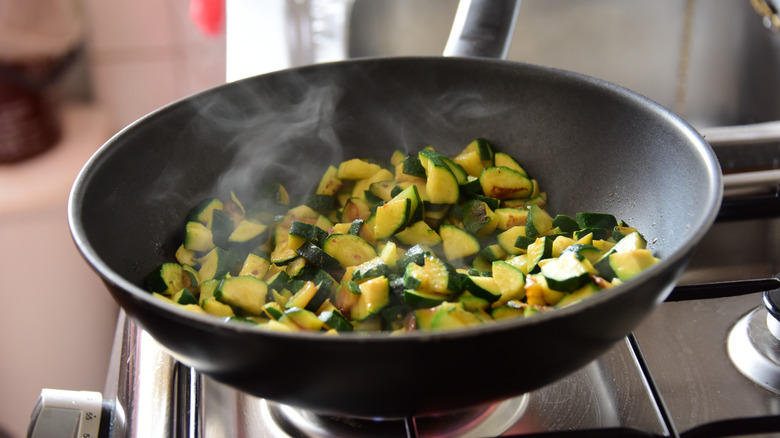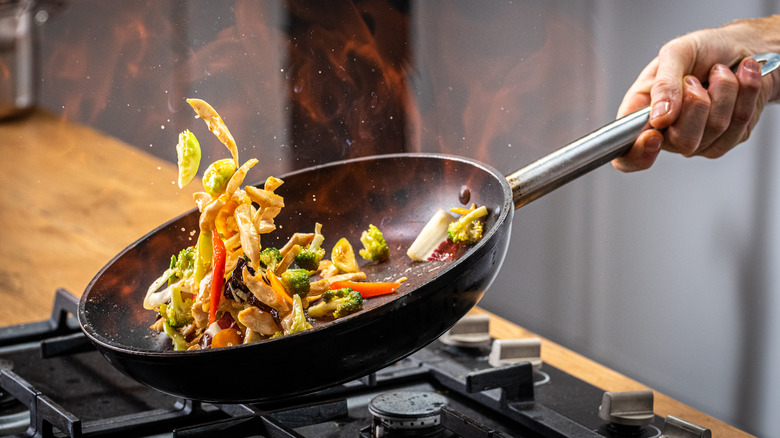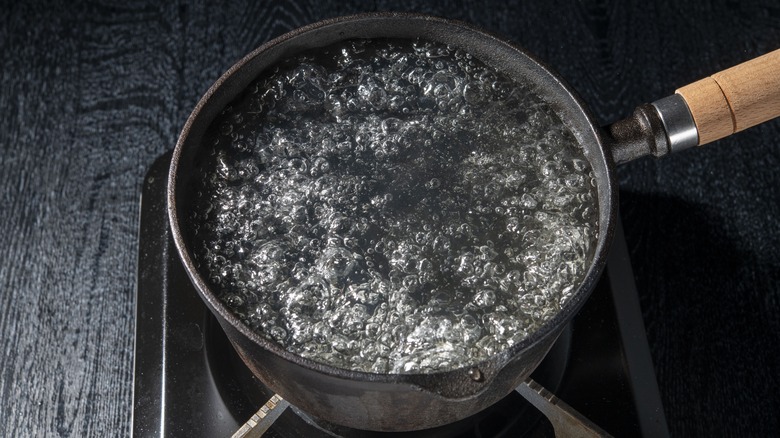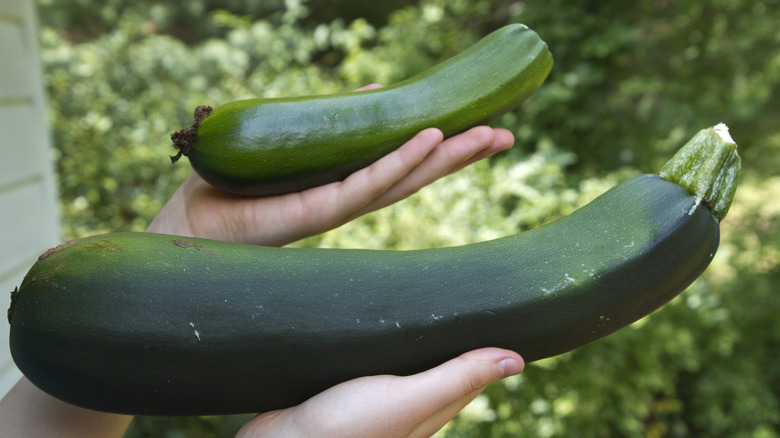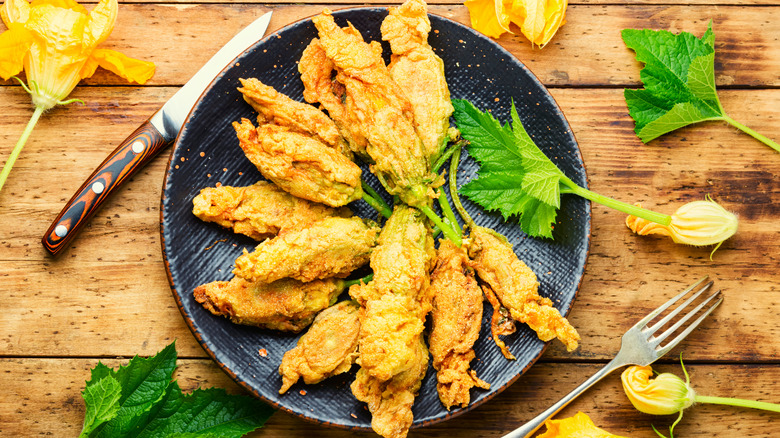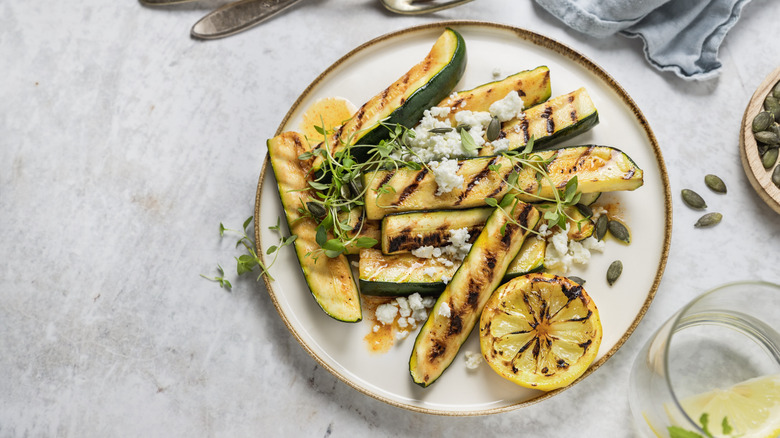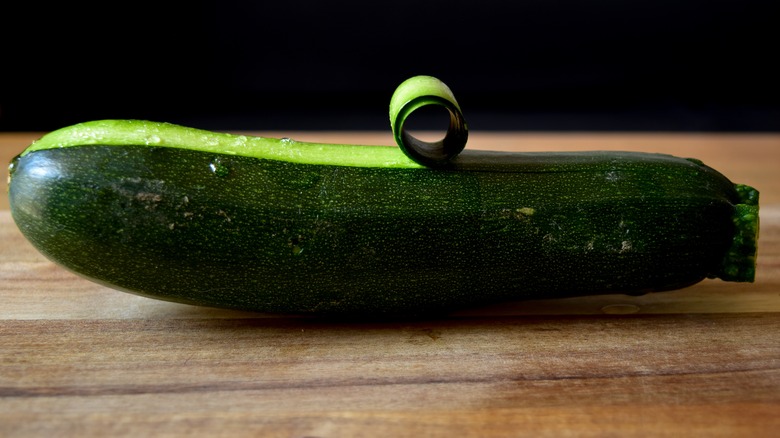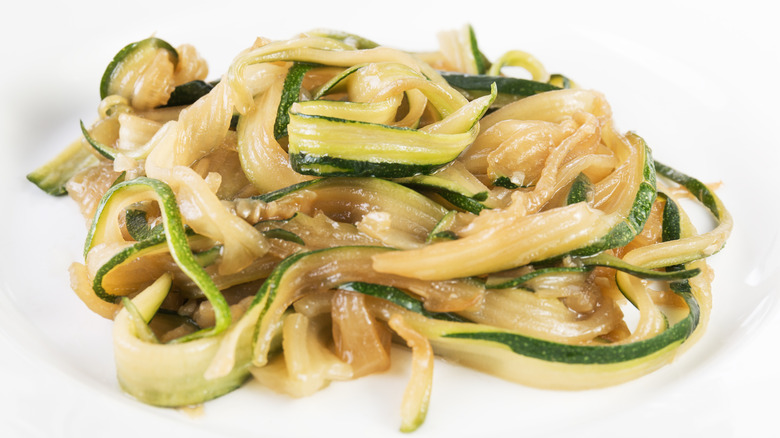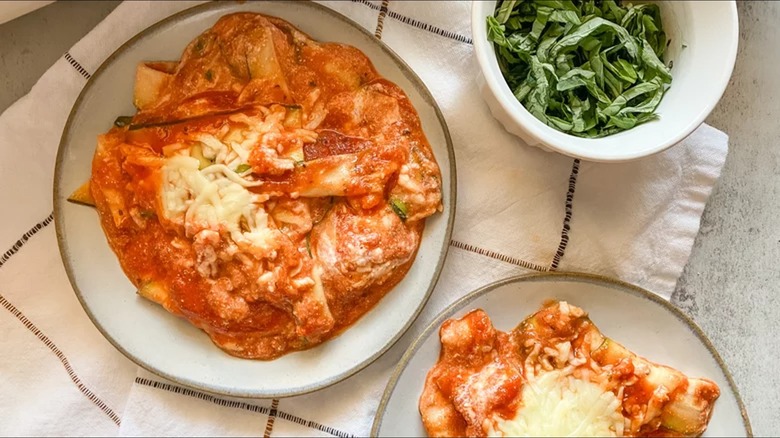The Worst Zucchini Mistakes You Can Make
There are many reasons to eat more zucchini. Full of antioxidants, low in calories, and an excellent source of B vitamins, it is one of the healthiest foods out there. Unlike hard vegetables such as broccoli or potatoes, or watery vegetables like tomatoes or cucumbers, zucchini can easily be thrown into a stir-fry without disrupting the timing or moisture content of your dish. They add a subtle yet distinctive flavor, and provide a pleasantly starchy texture that can even act as a low-carb substitute for spaghetti.
Although zucchini is usually an asset for cooks, it can also pose issues. For example, despite being full of starch, the summer squash can be notoriously soggy and even mushy. It can also be disappointingly bland, depending on how you cook it. Luckily, these pitfalls are not inevitable, and they can easily be avoided. Considering what a boon this veggie is in everyday cooking, it's worth understanding exactly how to get it right every time. We're running down several of the most common mistakes people make with zucchini and how to avoid them, so the next time you fire up the grill or pull out your favorite recipe for spiced zucchini bread, you won't end up disappointed with the results.
Not salting it to remove moisture
Zucchini is almost 95% water, so it's no wonder it can turn out mushy when cooked. But don't despair — it doesn't have to be mushy. All you have to do is minimize its moisture content, and there are multiple ways to do it. If you want to make absolutely certain that your zucchini doesn't get soggy, your best option is to start by removing the water with salt even before you start cooking it.
Salt is hydrophilic, meaning that it loves water. When you sprinkle salt over a moisture-rich food like zucchini and let it sit for 20 to 30 minutes, it draws out the moisture and reduces that 95% water content even before heat is applied. You don't need much salt either. Just a ½ teaspoon for each pound of zucchini will do. Not only do you get diminishing returns with extra salt when it comes to the moisture content, but it could also quickly lead to a vegetable so salty that it's inedible.
If you opt for this method, make sure to drain the zucchini or pat it dry with paper towels before you cook with it. There's no point drawing out all that moisture if you don't then remove it from the veggie.
Skipping the seasoning
Depending on whether you're a glass half empty or glass half full kind of person, you could either describe zucchini as bland or pleasantly subtle. It has neither the potency of an onion nor the fragrance of a vine-ripened heirloom tomato. It is, in short, crying out for seasonings, and whoever makes the mistake of cooking it without so much as a grind of pepper will be forgiven for condemning it as one of the least inspiring veggies at the grocery store. Add even the slightest of seasonings, however, and this unassuming squash comes to life.
There are many options for sprucing it up, but let's start with the obvious answer: garlic and onions. A brief sauté of onions, garlic, and zucchini makes a deliciously flavorful, healthy side dish to accompany meat or vegetarian main dishes. If you're looking for something a little less predictable, opt for Italian seasoning. It has just enough flavor to enhance the zucchini and adds to its air of summer freshness. We even have our own recipe for Italian seasoning if you don't already have some in your spice cabinet. All you need is dried basil, parsley, oregano, rosemary, and thyme.
Overwhelming it with flavor
On the other side of the coin, you don't want to make the mistake of overwhelming zucchini with flavor. It's tempting to do. When you have a main ingredient that lacks punch, it's only natural to reach for stronger flavors to dial it up a notch. But that would do a disservice to this vegetable which, although subtle, possesses a deliciousness all its own. At peak freshness, zucchini has a slight sweetness that is a grassier than nutty flavor of winter squashes. It might not be enough to carry a dish on its own, but masking it entirely would be a lost opportunity.
To avoid overwhelming your zucchini with flavor, you can follow one of two options. First, choose the other ingredients wisely, and second, use them in moderation. If you choose other mild ingredients, such as plain tomatoes, legumes, or sweet peppers, you can use them in equal measure without worrying that the zucchini will be drowned out. If you choose ingredients that have more kick to them, whether it's paprika, feta cheese, or garlic, make sure to use them with a light touch. In most cases, the less you use, the better the dish will taste.
Overcrowding the pan
Choosing the right size pan often feels like an unnecessary hassle. How are you supposed to know exactly how many slices of vegetables you're going to cook? You might intend to only use an onion, two carrots, a zucchini, and six mushrooms, only to discover an extra zucchini and a few stalks of celery at the bottom of your crisper that need to be eaten immediately to avoid spoiling. Or maybe you choose the pan that you think will accommodate everything and then find out halfway through adding the last ingredients that it absolutely will not. As long as it isn't overflowing, it's probably fine, right? Not in the case of zucchini.
One of the surest ways to get soggy zucchini is to cook it in a pan that doesn't allow each piece to touch the bottom. Usually, sautéing zucchini is an excellent way to quickly reduce its moisture, since the hot, dry heat makes the water quickly evaporate before it can steam the vegetable. When the slices of zucchini are overlapping, however, some pieces will not get hot enough for this process to happen, and you'll end up with a layer of water in the bottom of the pan and a mushy pile of zucchini on top. When in doubt, choose a pan that you think will be too big.
Never eating it raw
There are some vegetables that you should simply never eat raw. For example, experts advise against eating raw potatoes because they contain certain glycoalkaloids that can be toxic, even in small amounts. But there are many other veggies that don't have to be cooked to be enjoyed. Brussels sprouts, for example, are usually cooked in some way, even though they don't technically have to be any more than tomatoes do. Of these two categories, zucchini fits into the latter. You don't have to cook it, but almost all recipes call for doing so. Unlike raw Brussels sprouts, which can cause indigestion, raw zucchini has nothing going against it except tradition, and adding it to your culinary repertoire can yield spectacular results.
The most common and arguably most delicious use of raw zucchini is salads. Slicing it into thin ribbons and using it instead of lettuce provides an elegant twist on a classic salad recipe. Its starchy texture helps soak up dressing, while its fresh flavor will bring summer straight to your plate. If you want to ease yourself into the idea of raw zucchini, you can always add it as a garnish to a regular lettuce salad first and increase its ratio with other ingredients in subsequent meals.
Cooking it at a low temperature
Cooking at low temperatures has many benefits. Scrambled eggs, for example, are best when they are cooked low and slow, allowing them to become fluffy and tender rather than dense and rubbery. But whenever you have an ingredient with a high moisture content, it's better to cook it hot and fast if you want to avoid sogginess. The slower you cook zucchini, the longer it will take for its moisture to evaporate. If you cook it too slowly, that moisture might not evaporate much at all. It will just stick around in the pan, turning the zucchini into a mushy stew.
Whether you're grilling, sautéing, or roasting this ingredient, speed and heat are paramount. For sautéing, that means cooking it in a single layer on medium-high for about five minutes total. That's all you need. If it takes longer, the pan probably isn't hot enough. This cooking method will yield zucchini that is browned on both sides but not dried out — the perfect combination. You can also salt it first to lower the risk of mushiness even further.
Adding it to the pan too early
Different ingredients cook at different speeds. This is intuitive in many cases. Most of us would automatically add the onions to a pan first when making chili, but wait to add the parsley until the last minute when the chili is already dished into bowls and ready to serve. Zucchini isn't as delicate as a fresh herb, but it does have different cooking needs to other veggies, and for best results, it should be added at a strategic moment.
If you're making a stir-fry, dense veggies like potatoes, carrots, and cauliflower should come first after the onions and spices. These can take anywhere between 10 and 15 minutes to soften. Then come the medium-soft veggies like celery. Next are the softer veggies like mushrooms, zucchini, corn, and peas, which usually take about five minutes to cook. Last but not least are tender greens and garlic, which only take about a minute to cook.
Following this sequence not only avoids burned or undercooked veggies, it also ensures that delicate but moisture-rich ingredients like zucchini don't get mushy. No matter how hot the pan is, zucchini can start to fall apart if cooked for too long.
Boiling it
There's a reason you don't see many recipes that call for boiling zucchini. While it may work great for potatoes and broccoli, boiling is not the best method for cooking this delicate summer squash. In fact, it's almost guaranteed to ruin it. Zucchini is almost 95% water, and to avoid sogginess, you need to remove as much of that water as possible during the cooking process. In contrast, potatoes are less than 80% water and so dense that it can take 20 minutes of steaming or roasting before they show any signs of softening. Boiling zucchini, no matter how briefly, will inject it with even more moisture, turning it into a sludge not unlike green porridge.
The only time boiling zucchini is the way to go is if you're trying to feed it to an infant who can't eat solids yet and needs bland flavors. Even if you're planning to make zucchini soup, boiling is not the answer. The water dilutes its delicate flavor, and there are other ways to cook it quickly without rendering it tasteless and mealy. Sautéing, for example, takes all of five minutes and yields flavorful but tender results.
Choosing large zucchini
Whether you're picking a watermelon or a rotisserie chicken, it stands to reason that you'd want to pick the largest specimen. But that doesn't always equate to quality, and in the case of zucchini, that is particularly true. In fact, the larger the zucchini, the less appetizing it is likely to be.
Large zucchinis tend to be the older ones. As they mature, their water content increases, making them bland and mealy. If you choose a big zucchini expecting it to be plump and delicious, you'll be frustrated to discover that it is mushy, full of large, leathery seeds, and almost impossible to sauté without producing a puddle of moisture at the bottom of the pan. When buying zucchini, look for the small to medium-sized ones that have a bright green color and are firm rather than rubbery. The fresher they are, the less moisture they'll have and the more flavor they'll have.
Not eating the flowers
If you've ever grown zucchini, you'll know that, like tomatoes, they can get out of hand quickly. After giving them away to everyone you know and trying every zucchini-based recipe you can find, they can start to feel like more of an affliction than a treat. But before you decide that you've had enough of the plant for the year, don't forget about the blossoms. While they may not come up in recipes very often, zucchini blossoms can make a striking addition to a meal and may even make you a fan of the plant again no matter how tired you are of the squash.
Large, golden, and tissue-paper thin, zucchini blossoms are a sight to behold. You might even be tempted to put them in a vase and display them on your kitchen table. They are so delicate, however, that they close during the day to avoid the direct sunlight. If you're going to harvest them, eating them is the best way to enjoy them. Because of their fragility, many recipes for zucchini blossoms call for battering and lightly frying them which give them more structure, but you can also stuff them like cabbage leaves or add them to stir-fries as a visually striking alternative to spinach leaves.
Forgetting about the grill and the air fryer
There are so many ways to cook zucchini that it's easy to lose track of the options and fall back on old habits. You can never go wrong with a quick sauté, but if you have a grill or an air fryer, it's worth mixing it up every once a while.
Nothing beats the lightly charred flavor of a grill, and zucchini is no exception. Our recipe for garlicky grilled zucchini takes you through every step so you don't run the risk of burning the delicate veggie or ending up with undercooked, rubbery chunks of it either. You can even use a grill pan so you don't have to fire up the grill.
As for using the air fryer, the process is even simpler. Our air fried zucchini chips recipe defies any suggestion of sogginess and even gives potato chips a run for their money. You can also make a more traditional version by cooking them longer. Due to the air circulation of the air fryer, you won't have to worry about sogginess.
Peeling it
To peel or not to peel, that is the question with many fruits and vegetables. In some cases, the answer is pretty obvious. Oranges and bananas, for example, are hardly edible without removing the peels, while butternut squash is tough and unpleasant before peeling. For many other fruits and vegetables, however, it's more of a personal choice. Carrots and potatoes are easy to peel, and, since their surfaces are uneven, doing so can help remove stubborn dirt and grit.
When it comes to zucchini, however, there is little to be gained from peeling, and a lot to be lost. On an aesthetic level, peeling zucchini robs your recipe of its vibrant green color. Instead, you'll just have unidentifiable pieces of whitish-green starch. More importantly, however, the skin is where many of the health benefits of zucchini are stored. Powerful antioxidants like lutein, beta-carotene, and zeaxanthin are found in that paper-thin, dark green skin, and removing it would rob you of their cancer-fighting properties. Considering how laborious peeling fruits and veggies can be, choosing to leave zucchini skins intact is the best of both worlds. Just make sure to wash it thoroughly.
Not caramelizing it
Mention the word "caramelize" and you probably immediately think of flavor. This technique of slowly converting natural sugars into a brown, nutty sweetness is a slam-dunk in almost every respect. Whether you're doing it to onions or plain old sugar crystals, the results are tantalizing and impossible to miss.
You might not know it yet, but caramelized zucchini does exist and it is surprisingly delicious. Better yet, you don't need any fancy equipment, ingredients, or culinary education to make it. All you need is a skillet, some oil, and the summer squash itself. No matter what you're caramelizing, you'll need to arm yourself with patience, too. The process, by definition, takes time, and there is no good way to speed it up without compromising the results.
Caramelizing zucchini might seem like an exact contradiction to the general rule to cook it quickly and at a high temperature. However, caramelization is a unique process, and as long as you cook it long enough to burn off all the water that pools in the bottom of the pan, you'll have sweet, flavor-packed results. To make it, cut the zucchini into thick ribbons or grate it. Cook it on medium heat for at least 15 minutes and up to 45 minutes. You can use it in stir-fries, quiches, salads, or anywhere you would use caramelized onions.
Never turning it into a comfort food
Sure, zucchini is bursting with antioxidants and is extremely low in calories, but that doesn't mean it has to be a health food. In fact, for a veggie with such an impressive nutritional profile, it's remarkable just how well suited to indulgent recipes it is. For starters, it makes a delicious addition to sweet breads. Zucchini bread is a tried and true dessert (or breakfast) that never tastes like you're eating vegetables. Its starchiness blends perfectly with the pillow-soft bread and its sweetness rivals that of carrots.
For savory recipes, there are even more options. Our vegetarian zucchini lasagna may be low in carbohydrates, but it's practically swimming in cheese, just how any self-respecting lasagna fan would wish. This unassuming summer squash is also the perfect frying ingredient. Because of its starchiness and relative robustness, it can easily be battered and fried. Our easy fried zucchini recipe even throws in some Parmesan for good measure.
